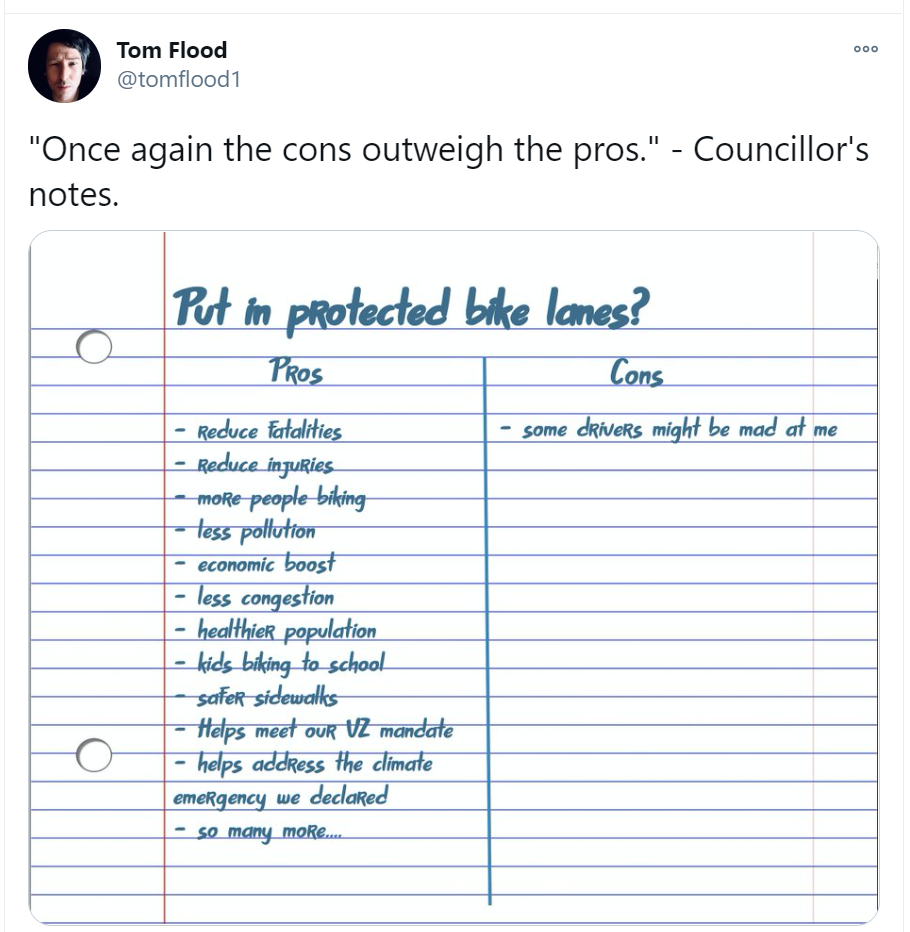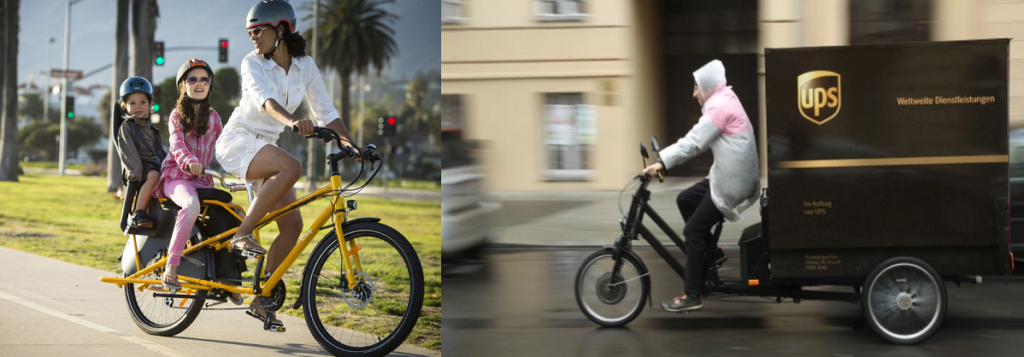The first phase of the Agnes Greenway project has been installed, and is getting a bit of feedback online. That’s good – the City hoped to receive feedback on this important piece of infrastructure as a part of how it is being rolled out. I will write another blog post about that as soon as I get time, but before I do, I want address this niche-popular meme created by Tom Flood that appeared in my twitter feed, and excuse me for feeling attacked:
…and add a bit of a retort from the viewpoint of a City Councillor oft criticized because I like the idea of installing protected bike lanes, and agree with almost all of the “Pros”.
Right off the top, I need to say, protected bike lanes are expensive, and cities are struggling right now with so many overlapping challenges and priorities. Yes, I hear, understand, and accept the argument that an integrated bike network will save us money in the long run and improve livability to far outweigh the costs, but that takes nothing away from the current challenge of the immediate capital costs required for a safe network. Proper bike lanes are not a few planters and green paint (the latter of which is inconceivably expensive – it would be cheaper by the square foot to make bike lanes of engineered wood flooring, but I digress). If we want them to be safe for all users, we need to install new signage and/or signals at all intersections. This can mean moving street lights and telephone poles and power conduit. Installing grade separations often means redesigning storm sewer infrastructure. We may need to move or re-engineer bus stops, curb cuts, pedestrian islands, street trees, and, yes, parking. When you expand this out to kilometres of bike route and scores of intersections, these changes are not cheap.
The retort to this, of course, is they are cheaper than road expansions. Which is kinda true, but not really helpful. This infrastructure is almost always built in urban areas like Downtown New Westminster: a built-out City that is essentially out of the building-new-roads business. I don’t mean that rhetorically; we have a policy goal to reduce road space in the City and convert it to active transportation and other uses, therefore we don’t really have a “road building” budget line. This means we can’t just re-allocate from there to a “Separated Bike Lane” budget line. It doesn’t work that way. Yes, we spend millions every year on road maintenance and upkeep, but taking away from that in a significant way will widen an infrastructure deficit (unmaintained roads get much more expensive to fix when the road base fails and safety is impacted when signal lights and road markings are not kept in good working order) and so much of the spending is on infrastructure that supports transit users, cyclists, pedestrians (including those with accessibility barriers) that it is difficult to argue for where cost cutting here can occur without impacting everyone – not just the car users we usually associate with “roads”.
The presumption in the Pro list above that bike lanes make sidewalks safer is a presumption reliant on very well designed bike lanes. Integrating safer cycling infrastructure with safer pedestrian infrastructure is a serious challenge, as the number of “conflict” zones increases. Cycling advocates will recognize how pedestrian bulge design often makes cycling feel less safe on some arterial roads, but are less likely to recognize how important those bulges are to improving the safety of other vulnerable road users. Conflicts inevitably arise between what cyclists need to feel safe and what other users (especially those with mobility or vision impairments) need to feel safe in the pedestrian space.
Emergent technologies are making this more difficult. At the same time E-bikes are opening up the freedom of cycling to many more people, modified scooters and e-bikes travelling at speeds wholly inappropriate for sharing space with those for whom we are trying to build AAA “All Ages and Abilities” space create uncertainty. I think most people are comfortable sharing safe bike lane space with most traditional cargo bikes (left), but not with electric powered cube vans disguised as tricycles that are starting to appear (right):
I’m not sure how we design for all of the variations on the spectrum, or even if we should. I have harped before about the need for a Motor Vehicle Act that reflects emergent technology, but we have a lot of work to do here. Public perception of safety, and resultant political support for separated bike lanes, are going to be influenced by how we do that job.
There are really good reasons to put the backbone of a safe cycling network in the same place your transit network already is. That is because your community and transit network have (hopefully) developed over time in a symbiotic way. Ideally, transit takes people from where they live to where they work, shop and go to school along as simple a route as possible to provide best service the most people. All good reasons to put cycling infrastructure exactly there. This complicates things, as transit and cycling routes are really challenging to integrate. Lane widths and turning radii that accommodate efficient bus movement don’t make the lanes safer for cyclists. Line of sight and signal challenges abound. Bus pull-ins create conflicts, floating bus stops create accessibility concerns and rely on sometimes expensive grade-separation. Do we move or adjust bus routes to accommodate this other mode, or choose less optimum routes to avoid transit conflict? I think the answer is a little from each column, but the Transit Authority and transit-reliant residents may not agree.
Which brings us to one of the least discussed issues or urban transportation: curb allocation. There are so many competing priorities for this precious resource in urban areas: the limited space on each block face where road meets boulevard. It is fine for cycling advocates to say, uh, “forget parking” (as I have myself on more than one occasion), but you can’t scoff off that this space is needed for everything from the aforementioned bus stops to loading zones for your Uber driver to assuring accessibility for Handi-Dart to having a place for the becoming-more-ubiquitous delivery trucks to stop while they offload your Amazon consumables. Bike lanes want to be on that curb space, and designing for these conflicts is not easy or without political cost.
There is no way around it, building bike lanes in a built-out urban area like New Westminster means taking something away. We simply don’t have the space to seamlessly slot functional, safe, AAA bike routes in without impacting the status quo of how that public space is used. Cycling advocates will usually reply that parking and driving lanes can be taken away, and in many cases, that is true. But when that means shifting a bus route that a senior relies on for their daily trips, or it means a disabled person no longer has the safe access to their Handi-Dart that they have relied upon, it’s really hard to be smug and tell people to just lump it.
I say all of this as someone who is feeling the burn of failure in my 6 years on a City Council because my community has not built the bicycle infrastructure I would like to see. The varying reasons for that are probably fodder for another too-long blog post. I also write as someone who is receiving the e-mails from people who are not happy to see the arrival of a new bike lane that has been in the plans for years, because it has disrupted their lives in ways perhaps not anticipated. I also get to enjoy the less sympathetic e-mails from people who seem empowered by the latest Bruce Allen rant about an alleged War on his Corvette – but those are easy for me to ignore, because I have been advocating for safe cycling infrastructure for a couple of decades and there is nothing new to be learned from those hackneyed arguments.
Unfortunately, there is also little to be learned from the increasingly hackneyed arguments of some cycling advocates (being a good “progressive”, I know how to hold my strongest criticism for my allies). Building safe cycling infrastructure is important, it is a good thing to do, and I lament we are not moving faster on it. But the political will to do so is not strengthened by pretending it is super easy to do, or that it is a cheap, easy silver bullet to fixing all of our urban challenges. It needs to be balanced with the many challenging needs local governments are dealing with right now. Bike lanes will help with some and will demonstrable make others harder. That’s the job of Governance, I guess.
So instead of throwing nameless Councilors under the proverbial bus by assuming their craven motivations, find those that are trying to move our urban areas in the right direction, and ask them how you can help them build the political will in your community to move bike lanes up the spending priority list. Because, trust me, there are many people reaching out to them every day telling them to do the opposite.
How can we help?
Depends on who “we” is. But I would suggest the average resident could tell your City Council that you want your tax dollars spent on Active Transportation infrastructure, even if it means tax increases in the short term to save money in the long term. Tell them that publicly, and when people write letters to the editor talking about how “bike lanes are always empty” and “bike lanes cause traffic chaos” and “what about my parking?”, don’t cede that space and let that be the conversations – reply. Join HUB or the BC Cycling Coalition to help them support Active Transportation. Vote for senior governments that support Active Transportation with real funding commitments, and not those that would rather spend on Freeway expansion. Answer surveys like this: https://www.beheardnewwest.ca/uptowncycling